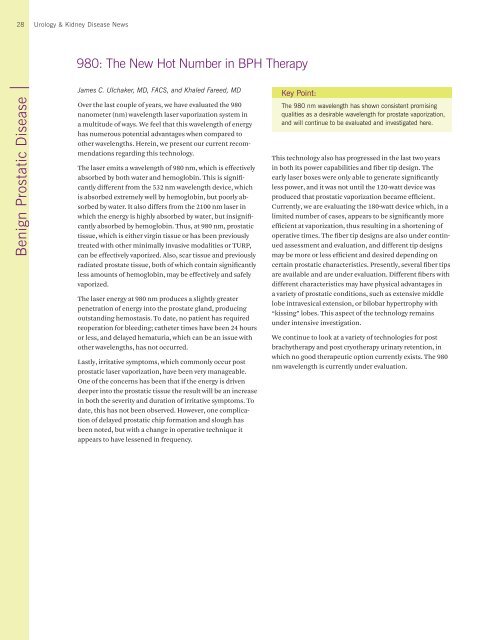Urology & Kidney Disease News Fall 2009 - Cleveland Clinic
Urology & Kidney Disease News Fall 2009 - Cleveland Clinic
Urology & Kidney Disease News Fall 2009 - Cleveland Clinic
Create successful ePaper yourself
Turn your PDF publications into a flip-book with our unique Google optimized e-Paper software.
28 <strong>Urology</strong> & <strong>Kidney</strong> <strong>Disease</strong> <strong>News</strong><br />
Benign Prostatic <strong>Disease</strong><br />
980: The New Hot Number in BPH Therapy<br />
James C. Ulchaker, MD, FACS, and Khaled Fareed, MD<br />
Over the last couple of years, we have evaluated the 980<br />
nanometer (nm) wavelength laser vaporization system in<br />
a multitude of ways. We feel that this wavelength of energy<br />
has numerous potential advantages when compared to<br />
other wavelengths. Herein, we present our current recommendations<br />
regarding this technology.<br />
The laser emits a wavelength of 980 nm, which is effectively<br />
absorbed by both water and hemoglobin. This is significantly<br />
different from the 532 nm wavelength device, which<br />
is absorbed extremely well by hemoglobin, but poorly absorbed<br />
by water. It also differs from the 2100 nm laser in<br />
which the energy is highly absorbed by water, but insignificantly<br />
absorbed by hemoglobin. Thus, at 980 nm, prostatic<br />
tissue, which is either virgin tissue or has been previously<br />
treated with other minimally invasive modalities or TURP,<br />
can be effectively vaporized. Also, scar tissue and previously<br />
radiated prostate tissue, both of which contain significantly<br />
less amounts of hemoglobin, may be effectively and safely<br />
vaporized.<br />
The laser energy at 980 nm produces a slightly greater<br />
penetration of energy into the prostate gland, producing<br />
outstanding hemostasis. To date, no patient has required<br />
reoperation for bleeding; catheter times have been 24 hours<br />
or less, and delayed hematuria, which can be an issue with<br />
other wavelengths, has not occurred.<br />
Lastly, irritative symptoms, which commonly occur post<br />
prostatic laser vaporization, have been very manageable.<br />
One of the concerns has been that if the energy is driven<br />
deeper into the prostatic tissue the result will be an increase<br />
in both the severity and duration of irritative symptoms. To<br />
date, this has not been observed. However, one complication<br />
of delayed prostatic chip formation and slough has<br />
been noted, but with a change in operative technique it<br />
appears to have lessened in frequency.<br />
Key Point:<br />
The 980 nm wavelength has shown consistent promising<br />
qualities as a desirable wavelength for prostate vaporization,<br />
and will continue to be evaluated and investigated here.<br />
This technology also has progressed in the last two years<br />
in both its power capabilities and fiber tip design. The<br />
early laser boxes were only able to generate significantly<br />
less power, and it was not until the 120-watt device was<br />
produced that prostatic vaporization became efficient.<br />
Currently, we are evaluating the 180-watt device which, in a<br />
limited number of cases, appears to be significantly more<br />
efficient at vaporization, thus resulting in a shortening of<br />
operative times. The fiber tip designs are also under continued<br />
assessment and evaluation, and different tip designs<br />
may be more or less efficient and desired depending on<br />
certain prostatic characteristics. Presently, several fiber tips<br />
are available and are under evaluation. Different fibers with<br />
different characteristics may have physical advantages in<br />
a variety of prostatic conditions, such as extensive middle<br />
lobe intravesical extension, or bilobar hypertrophy with<br />
“kissing” lobes. This aspect of the technology remains<br />
under intensive investigation.<br />
We continue to look at a variety of technologies for post<br />
brachytherapy and post cryotherapy urinary retention, in<br />
which no good therapeutic option currently exists. The 980<br />
nm wavelength is currently under evaluation.
















